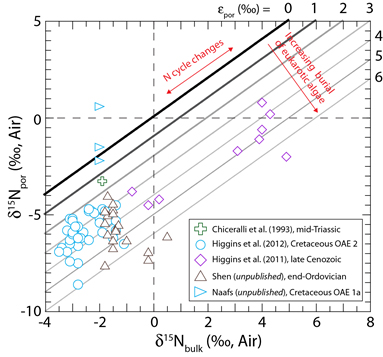2015 Annual Science Report
 Massachusetts Institute of Technology
Reporting | JAN 2015 – DEC 2015
Massachusetts Institute of Technology
Reporting | JAN 2015 – DEC 2015
Earth's Evolving Nitrogen Cycle - Implications for Community Complexity and Stability
Project Summary
This project examines nitrogen isotope patterns in Proterozoic and Paleozoic rocks, as part of a broader effort to understand the co-evolution of Earth’s redox cycles and marine ecosystems. The results are being incorporated into a growing framework of data and models that have as their primary objective to show how planetary geochemical cycles evolve with and/or help to record signatures of living systems – both microbial and complex. The project aims to yield a better understanding of the transition from primarily anoxic to primarily oxic deep oceans, and how that transition is mirrored in nutrient budgets (i.e., nitrogen) and the marine ecosystems that depend on the stability of these cycles. Understanding N-cycling throughout Earth’s history has critical implications for the evolution of complex marine ecosystems on geologic timescales.
Project Progress
A fundamental control on marine productivity is the supply and recycling of bio-available nitrogen (N) in the photic zone. Thus, understanding N-cycling throughout Earth’s history has critical implications for the evolution of complex marine ecosystems on geologic timescales. Records of the marine N cycle are preserved in the isotopic composition (δ15N) of sedimentary organic material. In the modern ocean, the average seawater nitrate isotope value of ~ +5‰ is driven by water column denitrification, which preferentially removes 14N, enriching 15N in the remaining nitrate pool. However, during broad stretches of Paleozoic, there were several extended intervals with δ15N values < 0‰, and the Proterozoic remains almost entirely unexplored. Modern N-cycling processes, mainly denitrification, can explain fluctuating values above 0‰. In contrast, the exceptionally low values for δ15N during the early-mid Paleozoic (≤ -3‰) cannot be explained through the modern framework of competing effects of denitrification and N-fixation. These patterns lead to the question: What process causes sediments to have δ15N values < 0‰? We are exploring this question under the hypothesis that the δ15N record may be a robust indicator of the history of Earth’s oxygenation.
Sedimentary porphyrins, the tetrapyrrole skeletons of ancient chlorophyll molecules, preserve primary N isotopic signals. We have developed a rapid approach to measure δ15N values of nitrogen in porphyrins (Higgins et al., 2009). These measurements allow us to evaluate two fundamental biogeochemical controls on the ancient marine nitrogen cycle: patterns in the absolute value of δ15N supplied to the photic zone, and the type of organism responsible for most of this production (Eukaryotes or Cyanobacteria). The latter is evaluated using the parameter εpor, which is the approximate difference between δ15N of total organic nitrogen in the source rock (measured as whole rock or kerogen) and δ15N of the porphyrin: εpor ≈ δ15Ntotal – δ15Npor.
This value is taxonomically distinct and likely is related to intracellular fractionations associated with biosynthesis. Eukaryotes have εpor = 5 ± 2‰, and marine Cyanobacteria have εpor = 0 ± 2‰ (Higgins et al., 2011). Using this approach, we were able to determine three key features of episodes of negative δ15N values: (1) 15N excursions can be out of phase with 13C excursions; (2) values of 15N were < 0‰ cannot be explained by a change in the type of primary producer; and (3) export production to sediments appears to be dominantly eukaryotic throughout the Phanerozoic. These results lead to some obvious questions: When did the δ15N signature of primary production become > 0‰? Our recent modeling work suggests that negative or near-zero values of δ15N indicate an ocean with significant (possibly > 50%) anoxic deep basins dominated by ammonia cycling (Naafs et al., in prep). Ventilation of the deep oceans with oxic waters is an important turning-point in Earth’s redox history.

Additional data on this problem is being collected by Greg Henkes, a post-doctoral investigator in the Pearson lab. In collaboration with UC-Riverside team members Noah Planavsky (Yale University), Gordon Love (UC-Riverside), and a group from the Georgia Institute of Technology, including Ellery Ingall, we have obtained a number of Proterozoic and Paleozoic shales which we already know contain sufficient porphyrin for isotopic measurements (Table 1). We anticipate completing the analyses in 2016.
Publications
-
Newman, D. K., Neubauer, C., Ricci, J. N., Wu, C-H., & Pearson, A. (2016). Cellular and Molecular Biological Approaches to Interpreting Ancient Biomarkers. Annual Review of Earth and Planetary Sciences, 44(1), 493–522. doi:10.1146/annurev-earth-050212-123958
- Pearson A (2016) Lipids (Bacteria and Archaea). In: Earth Sciences Series, Encyclopedia of Geochemistry, Ed. W. White; Springer Meteor. (In press).
-
PROJECT INVESTIGATORS:
-
PROJECT MEMBERS:
Greg Henkes
Co-Investigator
David Johnston
Collaborator
Andrew Knoll
Collaborator
Alan Rooney
Collaborator
-
RELATED OBJECTIVES:
Objective 4.1
Earth's early biosphere.
Objective 4.2
Production of complex life.
Objective 5.2
Co-evolution of microbial communities
Objective 5.3
Biochemical adaptation to extreme environments
Objective 6.1
Effects of environmental changes on microbial ecosystems

